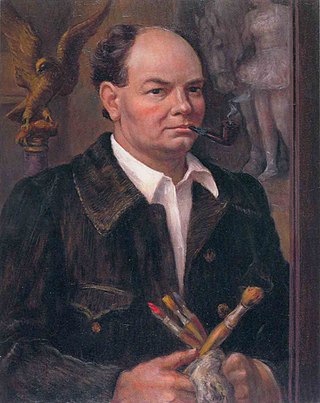
John Steuart Curry was an American painter whose career spanned the years from 1924 until his death. He was noted for his paintings depicting rural life in his home state, Kansas. Along with Thomas Hart Benton and Grant Wood, he was hailed as one of the three great painters of American Regionalism of the first half of the twentieth century. Curry's artistic production was varied, including paintings, book illustrations, prints, and posters.
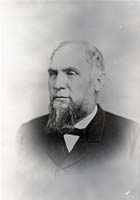
George Washington Glick was the ninth Governor of Kansas.
Education in Kansas is governed at the primary and secondary school level by the Kansas State Board of Education. The state's public colleges and universities are supervised by the Kansas Board of Regents.

The Kansas Department of Agriculture (KDA) is a department of the government of Kansas under the Governor of Kansas. It is responsible for providing services and expertise that promote agriculture and protect Kansas' food supply and natural resources while stimulating economic growth. The head of the Department is the Secretary of Agriculture, who is appointed by the Governor, with the approval of the Kansas Senate.

Ichthyornis is an extinct genus of toothy seabird-like ornithuran from the late Cretaceous period of North America. Its fossil remains are known from the chalks of Alberta, Alabama, Kansas, New Mexico, Saskatchewan, and Texas, in strata that were laid down in the Western Interior Seaway during the Turonian through Campanian ages, about 95–83.5 million years ago. Ichthyornis is a common component of the Niobrara Formation fauna, and numerous specimens have been found.
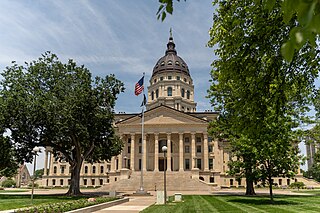
The Kansas State Capitol, known also as the Kansas Statehouse, is the building housing the executive and legislative branches of government for the U.S. state of Kansas. Located in the city of Topeka, which has served as the capital of Kansas since the territory became a state in 1861, the building is the second to serve as the Kansas Capitol. During the territorial period (1854–1861), an earlier capitol building was begun but not completed in Lecompton, Kansas, and smaller structures in Lecompton and Topeka were where the territorial legislatures met.

Pawnee is a ghost town in Geary County, Kansas, United States, which briefly served as the first official capital of the Kansas Territory in 1855. Pawnee was the territorial capital for exactly five days – the legislature met there from July 2 to July 6 – before legislators voted to move the capital to Shawnee Mission, which is located in present-day Fairway. It may be the shortest-lived capital of any U.S. state or territory.

The State Library of Kansas is a department within the state government of Kansas, with locations in Topeka and Emporia. Ray Walling was appointed acting State Librarian in June of 2022. On January 19, 2023, Walling was confirmed by the Kansas Senate as the 18th Kansas State Librarian.

Francis Huntington Snow was an American naturalist and educator. He spent more than forty years at the University of Kansas, first as a professor of natural history and then as chancellor. He was interested in several fields of science including botany, ornithology and geology but his primary focus was entomology. He was well-known as a field naturalist, based on 26 years of field collecting trips that he organized and led throughout Kansas, Arizona, Colorado, New Mexico and Texas. During these excursions, he and his students collected a quarter-million insect specimens representing some 21,000 species.

The Boston Society of Natural History (1830–1948) in Boston, Massachusetts, was an organization dedicated to the study and promotion of natural history. It published a scholarly journal and established a museum. In its first few decades, the society occupied several successive locations in Boston's Financial District, including Pearl Street, Tremont Street and Mason Street. In 1864 it moved into a newly constructed museum building at 234 Berkeley Street in the Back Bay, designed by architect William Gibbons Preston. In 1951 the society evolved into the Museum of Science, and relocated to its current site on the Charles River.

Benjamin Franklin Mudge was an American lawyer, geologist and teacher. Briefly the mayor of Lynn, Massachusetts, he later moved to Kansas where he was appointed the first State Geologist. He led the first geological survey of the state in 1864, and published the first book on the geology of Kansas. He lectured extensively, and was department chair at the Kansas State Agricultural College.

The Albany Institute of History & Art (AIHA) is a museum in Albany, New York, United States, "dedicated to collecting, preserving, interpreting and promoting interest in the history, art, and culture of Albany and the Upper Hudson Valley region". It is located on Washington Avenue in downtown Albany. Founded in 1791, it is among the oldest museums in the United States.
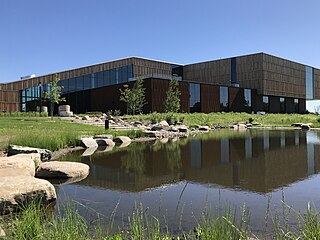
The Bell Museum, formerly known as the James Ford Bell Museum of Natural History, is located at the University of Minnesota's Saint Paul campus. The museum's current location on the Saint Paul campus opened in 2018. The Minnesota wildlife dioramas focus on animal specimens native to the state. The museum also houses the digital Whitney and Elizabeth MacMillan Planetarium. The museum is part of the university's College of Food, Agricultural and Natural Resource Sciences. The museum's former location on University of Minnesota's Minneapolis campus closed in January 2017.

The Hungarian Natural History Museum in Budapest, dating back to 1802, houses the largest natural history collections of Hungary and the region.

The Kansas Museum of History is the state historical museum in Topeka, Kansas, United States. It presents Kansas history from the prehistoric to modern eras in 30,000 square feet (2,800 m2) of exhibits. The galleries feature a train, full-sized tipi in the Southern Cheyenne style, a 1950s diner, and many other large features. Major topics covered in the main gallery include Native American tribal history, westward movement on the Oregon and Santa Fe trails, early settlers, the Bleeding Kansas and Civil War eras, and Populism at the turn of the 20th century.

The Kansas Historical Society is the official state historical society of Kansas.
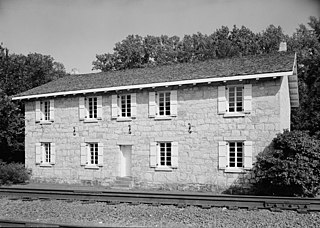
The First Territorial Capitol of Kansas is the sole remaining building of the ghost town of Pawnee, Kansas. The city served as the capital of the Kansas Territory for five days before it was moved to present day Lecompton, Kansas, and the town became part of neighboring Fort Riley. The building was the meeting place for the first elected Territorial Legislature in 1855. After falling into disrepair, the structure was restored in 1928 and today it serves as a history museum operated by the Kansas Historical Society and supported through The Partners of the First Territorial Capitol.
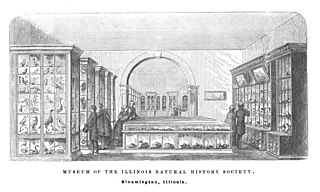
The Illinois Museum of Natural History was founded as the Museum of the Illinois State Natural History Society at the Illinois Normal School, Bloomington, Illinois, in 1858. The museum operated until 1877 on the third floor of what became Illinois State University Old Main building.
Lumina Cotton Riddle (1871–1939) was an American botanist. She was a direct descendant of John Cotton.
















